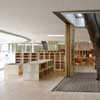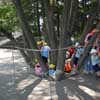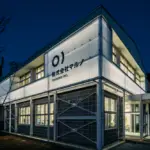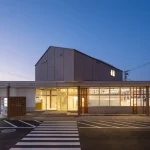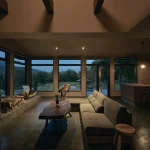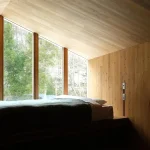The Roof House, Fuji Kindergarten, Building, Architect, Picture, Project, Design, Photo
The Roof House Fuji : Kindergarten Architecture Japan
Japanese Kindergarten – Roof House – design by Tezuka Architects
11 Sep 2008
The Roof House
Date built: 2007
Design: Tezuka Architects
Photographs : Katsuhisa Kida
Eaves
There are no balustrades in the Roof House. The kindergarten directors said that it would be good if this kindergarten building also had no balustrades. When we made the Roof House, the husband eliminated the balustrades by merely saying, “there were no balustrades on the roof deck of our previous house, and looking around the neighborhood there are no other houses with balustrades on the roof.”
Yet a kindergarten without a balustrade is impossible. The married couple that run the kindergarten made a proposal for a device in which children who fall could be caught by a net projecting out from the eaves, but this was no good. We had no answer to the question of what the children who were so caught would then do. The allure of having no balustrades lay in the eaves. The eaves are not just a problem of appearance. Sitting on the eaves is comfortable.
Finally, after a period of trial and error, we were able to keep the eaves seating by encircling the roof with slender balusters at a maximum spacing of 11cm, too small for a child’s head to enter. Feet can pass through an 11cm gap, unless they are especially big ones, and most adults can also hang their legs over the eaves. On the day the building was handed over, four hundred and fifty kindergarten pupils sat on the eaves. A thousand pairs of socks danced on the eaves. All the people involved couldn’t stop their tears of gratitude.
The eaves have been lowered to the legally permitted limit. The height of the ceiling facing the courtyard is only 2.1m. A man of normal height can easily reach the eaves with his hand. 2.1m is sufficient for a child. The lowness of the roof means that the top of the roof is near to the underside of the roof. Looking at the roof on the other side of the courtyard, events on the roof can simultaneously be seen. The roof deck slopes toward the courtyard, so even if a person goes further back on the roof, their whole body is visible, right down to their feet. If you jump a little from the garden, you can touch the hanging feet of the children.
To cope with falling dead leaves, a wide-open horizontal gutter was specified at the eaves. The collected rainwater falls from gargoyles in four places into four large rain drain pans in the courtyard. When it rains, the children gather around the waterfalls from these gargoyles. The children love this flowing water.
Nets around the trees
Around the trees, we made use of the ideas of the married couple that run the kindergarten. Holes have been inserted in the roof for trees to project through. We initially tried surrounding them with a 1.1m-high handrail, but the children could pass through it without any trouble, so the final result was a net specifically designed to surround the trees. Although it is difficult to climb a zelkova tree from ground level, it is easy to do so from roof height. Even today, the surroundings of the zelkova trees swarm with children.
Directionality of the roof
The roof deck is roughly aligned in a single direction. With an oval, the structural lines would probably be applied radially, but the shape of this building is not an oval. There is also no center to be aimed at, nor an index for its transformation. Trying to apply radial boards to the model was really uncomfortable. The building was originally defined with distortions, leading to a condition in which an accurate deck would have to bend the rules. While the building seems to have a center, it is a space without a center. In this kindergarten, neither the desks nor the furniture are aligned in rows. Rather than altering it, furniture that does not lend itself to alignment in rows was chosen. The kindergarten pupils sit in randomly dispersed directions, only turning their heads toward the teachers when necessary. The places under the roof are entirely equal, including those of the kindergarten directors.
Distorted oval
The oval has been distorted. This is the result of scanning in a hand-drawn sketch, and linking it with spline curves. It indeed caused trouble for our staff and on site. There is no regularity to the variations in the curve, and there are also parts that are close to being straight lines. Inaccurate construction is not responsible for the swaying of the eaves when you stand on them on site. Although the roof is sloped to follow the water drainage slope, the eaves on the outer perimeter and inner perimeter are each fixed. On the other hand, the width of the building expands and shrinks in accordance with the sketched lines. As a result, the roof appears smooth but is actually the three-dimensional curved surface of a delicately changing hyperbolic shell. A hand can instantaneously give answers that cannot be achieved on a computer. When solving delicate site relationships, such as preventing the trees from protruding, a mouse is only a hindrance.
Entirely openable kindergarten building
This kindergarten building is used entirely open for two thirds of the seasons throughout the year. This has already been tested, because the building was built in two phases and so half of it has been in use since summer. Therefore, the basic state of this building is with the windows open. The sliding doors directly follow the distorted oval shape. With the ground surface and room interiors at almost the same level, there is no sense of having to take off your shoes, and the distinction between where outside stops and where inside starts doesn’t apply. This kindergarten is an outdoor corridor. Going to each place is like taking off your shoes to visit a house. There are no slippers. Thinking about it, putting on slippers when indoors is a strange custom that only exists in the Japanese educational environment. Even in a residence or a workplace, there are no slippers for the general public. Put strongly, even in the cold of midwinter, your bare feet won’t be cold if Korean stove-type air-conditioning has been installed throughout the building. Nor does it have the unnatural heat of floor heating that uses electricity or warm water. It is a microclimate that envelops the entire building.
Mountain under the stairs
To reach the slide, you ascend a stair to ascend a mountain of soil about one meter in height. Because the stairs are low, we considered that there would be no injuries even if someone fell, but to be honest, it was also because we were aware that children would enjoy the heap of earth. The shape of the mountain was prepared by our students from the university. If we used a power shovel, it would unavoidably become an unpleasant crew-cut shape. The mountain was difficult to make, but as we expected, the children love it. No children fall from the stairs and get injured, either. There is a problem, however. The children noticed that the soil of the mountain is softer than the ground surface, and so every day they scrape some off to make mud pies. It has now become a very steep slope. We must again go and pile it up with our students.
Play equipment without requirements
The play equipment that we made here comprises just one slide. There is not a single piece of play equipment on the roof. The truth is, we gave it up because there was no money, but we think the result of having no play equipment is really good. The rooftop itself becomes the play equipment. What was needed here was a roof. During construction, we went to see Gaudi’s Casa Mila. Our purpose was to go to see the roof, which is full of strange, irregular chimneys and windows. Actually, we had visited it seventeen years previously. There is no play equipment at Casa Mila. That’s obvious, because it’s not a kindergarten, but neither our four-year-old child nor our one-year-old child could stop running around and shouting. No matter how many times they fell down and grazed themselves and started crying, they were soon running around again. It is not only the children that were enjoying it. The adults were also cheerful. Incidentally, not a single item of play equipment appears in the movies of Hayao Miyazaki, which are so beloved by children. Adults as well as children enjoy Hayao Miyazaki’s movies.
“The house of Satsuki and Mei” that appears in My Neighbor Totoro is a designer’s muddled combination of Japanese and Western-style house extensions. In one scene, they search for a concealed stair to the second floor. They are alarmed by a head that projects from a round shoji screen. However, what we both enjoyed was that it was a very ordinary architectural element. It wasn’t an invented device. What is important is that it is not “given,” but “found.” If it is made to fit a child, an adult can’t enjoy it. After all, adults and children have different sightlines. At the same time, a child’s sightline is not the same for each person. Their backs also differ in physical strength. Their preferences are also different. If everything is given, we can’t choose sightlines for ourselves. Play equipment comprises tools devised by adults to give children ways of playing. Playgrounds are given, and ways of playing are restricted. Children are experts at finding locations by themselves.
Children can find locations on the rooftop of the Fuji Kindergarten by relying on the skylights. On the first day the roof was joined in a loop, the teachers guided each class around the rooftop, but the children never stayed with their teachers. They gathered around the skylights and didn’t move. While making a full revolution, only a few people remained behind the teachers. From the nursery rooms below, the heads of friends peeping from above seem interesting. The roof is sloping. Just because of this slope, running becomes fun. Even the children who usually don’t run will race around this roof. There are said to be children who do thirty laps in the mornings, but thirty laps is 5500 meters, and there is nowhere in Tokyo where kindergarten pupils would run this distance without compulsion.
Tree roots and foundations
To preserve a tree is to preserve its roots. With regard to zelkova trees, the spread of the roots is only the span of the branches. Therefore, there are no foundations around the tree roots. The roots extend from the courtyard across the width of the building to the exterior face of the oval. At least the parts under the building do not cause an increase in weight, so flat slabs can span from foundation to foundation. To prevent the areas around the roots being infiltrated by the alkali compounds in concrete, a sheet underlay was installed prior to the leveling concrete. The digging and soil stabilization proceeded while avoiding the roots, and it was more like an excavation site than a construction site.
Outdoor faucets
Faucets for outdoor use are indispensable for the garden of a kindergarten. Before we made basins for outdoor use, our students investigated various kindergartens, including the nursery schools our own children attend, and discovered not a single one of their basins was unblocked. Of course, there are probably no problems at prestigious schools, where they have people who clean very often as well as a selection of well-behaved children, but this is usually impossible.
At Fuji Kindergarten, we observed why they become blocked, and saw that the children get together and use shovels to jam mud pies into the squares of the grille. That’s why they get blocked. Depending on the kindergarten, only the faucets stand high, and the drain holes do not appear unless they are excavated. For ordinary concrete drain pans to be visible in this kindergarten would be unsightly. The image of the exterior faucets is like grass growing up from the ground. The freely curved faucets grow from the ground, and pour water onto the ground. Round slices of tree trunks are arranged on the ground, and water enters their crevices from below ground. Large water drain pans have been installed underneath.
In conclusion
Our scheme is the “end of an era.” The end of an era is a treasure house of “joys” that have now been abandoned. Modern conveniences have deprived children of sensation. They don’t know that when it rains, the soil gets wet. They don’t know that if a person is hit, they get injured. They don’t know the reason why a light bulb glows. What we want to teach through this building is “common sense.” Common sense comprises those values of human society that are unchanging, even across eras. Yesterday, we spent the whole day visiting the family of the Roof House. When we first met them, the sisters were in the second grade and fourth grade of elementary school, and they are now in the first grade and third grade of high school. Still, the atmosphere flows unchanged from those days. We think the Roof House will probably still be unchanged when this married couple reaches the end of their lives. And we think that the Fuji Kindergarten will be the same even after fifty years have passed.
Fuji Kindergarten images / information from Tezuka Architects 310708
Photographs © Tezuka Architects
World Architecture Festival Awards 2008 : Learning Category Shortlist
Montessori School Fuji Kindergarten – Building Information
Location:
Tachikawa, Tokyo, Japan
SITE AREA: 4791.69m2
FOOT PRINT AREA: 1699.10m2
TOTAL FLOOR SPACE 1094.83m2
CEILING HEIGHTS (VARIES): 2.172m
TOTAL HEIGHTS (VARIES): 2.785m
FLOORS: 1 LEVEL
Master planning: Feb 2005-March 2006
Phase 1 construction (50%): March 2006 – Sep2006
Phase 2 construction (100%): July 2006 – Jan 2007
Owner:
Montesoli School Fuji Kindergarten
Creative Director:
Kashiwa Sato
Architect’s firm name, address, phone, and fax number:
TAKAHARU+YUI TEZUKA ARCHITECTS
1-19-9-3F, Todoroki, Setagaya, Tokyo, JAPAN
Phone: 81(0)3 3703 7056
Fax : 81(0)3 3703 7038
Building Construction
Takaharu+Yui TEZUKA/ TAKAHARU+YUI TEZUKA ARCHITECTS
Masahiro Ikeda/MASAHIRO IKEDA co.,ltd
Original Design
Takaharu+Yui TEZUKA/ TAKAHARU+YUI TEZUKA ARCHITECTS
Takaharu Tezuka, Yui Tezuka, Chie Nabeshima*, Ryuya Maio, Asako Kompal Kousuke Suzuki Naoto Murakaji Shigefumi Araki Shuichi Sakuma
Masahiro Ikeda/MASAHIRO IKEDA co.,ltd
Construction/Maintenance
Takaharu+Yui TEZUKA/ TAKAHARU+YUI TEZUKA ARCHITECTS
Takaharu Tezuka, Yui Tezuka Chie Nabeshima *Asako Kompal Kousuke Suzuki
Masahiro Ikeda/MASAHIRO IKEDA co.,ltd
Associate architect(s),: if applicable:
Takenaka Corporation Kenji Takeshima Masaaki Hiroshima Satoko Inoue Mitsuo Seki
Tezuka Lab at Musashi Institute of Technology Takayuki Utsugi Yusuke Hujita Kanako Takeshita Momoko Yoshida Miki Ajioka Nao Otsuka Keiichi Kato Naoko Sato Noriko Tsujimura Megumi Nakamura Yusuke Tanaka Atuko Ota
Engineer(s)
Masahiro Ikeda/MASAHIRO IKEDA co.,ltd
Lighting:
Masahide Kakudate / Masahide Kakudate Lighting Architect&Associates
Masahide Kakudate, Junko Watanabe *
Mechanical,Electrical Engineering
Takenaka Corporation Hiroshi Kanemaru
*demolished [Ed. assume no longer there….]
Fuji Kindergarten – main page on The Roof House
Ring Around a Tree, Japan
Tezuka Architects
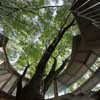
photograph : Katsuhisa Kida
Location: Fuji, Japan, East Asia
Japanese Architecture
Japanese Architectural Designs – chronological list
Japanese Architecture – key projects
Japanese School Buildings
Otonoha School, Ibaraki, Osaka, Japan
Design: Tetsuya Matsui, UZU
Otonoha School Japan
French School, Tokyo
Design: albert abut architecture
Japanese Language School
Orandajima House Afterschool Facility, Yamada machi
Utsukushigaoka Elementary School
Toyo Ito : Japanese architect
Buildings / photos for the Fuji Kindergarten Architecture page welcome

